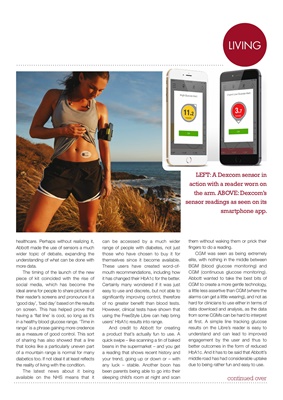
KITLIVING
Libre technology using Flash Glucose
Monitoring*. CGM was not that well
known or understood at the time, both
in the diabetic user base and in diabetes
healthcare. Perhaps without realizing it,
Abbott made the use of sensors a much
wider topic of debate, expanding the
understanding of what can be done with
more data.
And the timing of the launch of the
new piece of kit coincided with social
media being the ideal arena for people to
share pictures of their reader's screens -
pronouncing it a good day, bad day and
proving once and for all that having a 'flat
line' is cool, so long as it's in a healthy
blood glucose range, and also that having
a line that looks like a particularly uneven
part of a mountain range is also normal for
many a diabetic. It's helped to show
The latest news about it being
available on the NHS means that it
can be accessed by a much wider continued over
LEFT: A Dexcom sensor in
action with a reader worn on
the arm. ABOVE: Dexcom's
sensor readings as seen on its
smartphone app.
range of people with diabetes, not just
those who have chosen to buy it for
themselves since it become available.
These users have created word-ofmouth recommendations,
including how
it has changed their HbA1c for the better.
Certainly many wondered if it was just
easy to use and discrete, but not able to
significantly improving control, therefore
of no greater benefit than blood tests.
However, clinical tests have shown that
using the FreeStyle Libre can help bring
users' HbA1c results into range.
'Time in range' is a phrase gaining
more credence as a measure of good
control, it being an indicator of better
control. And credit to them for creating
a product that's actually fun to use. A
quite swipe - like scanning a tin of baked
beans in the supermarket - and you get
a reading that shows recent history and
your trend, going up or down or - with
any luck - stable. Another boon has
been parents being able to go into their
sleeping child's room at night and scan
them without waking them or prick their
fingers to do a reading.
CGM was seen as being extremely
elite, with nothing in the middle between
BGM (blood glucose monitoring) and
CGM (continuous glucose monitoring).
Abbott wanted to take the best bits of
CGM to create a more gentle technology,
a little less assertive than CGM (where
the alarms can get a little wearing), and
not as hard for clinicians to use either in
terms of data download and analysis, as
the data from some CGMs being hard
to interpret at first. A simple line tracking
glucose results on the Libre's reader
is easy to understand and can lead to
improved engagement by the user with
their diabetes control, leading to improved
outcomes in the form of reduced HbA1c.